Your water softener might be failing if you notice hard water spots reappearing, declining water pressure, unusual regeneration noises, fluctuating salt usage, persistent dry skin, or premature appliance wear. These issues often develop gradually but significantly impact your home’s water quality and efficiency. Unlike traditional systems, salt-free water conditioners using TAC technology prevent scale buildup without electricity or waste water, offering a permanent solution to these common softener problems.
Key Takeaways
- Hard water spots reappearing on dishes and glassware indicate your water softener is no longer removing minerals effectively.
- Decreasing water pressure throughout your home can signal mineral buildup from softener failure.
- Unusual fluctuations in salt consumption, either too high or too low, suggest system malfunction.
- Strange noises during regeneration cycles like grinding, banging, or clicking point to mechanical problems.
- Salt-free water conditioners using TAC technology offer a maintenance-free alternative that never requires salt refills.
Hard Water Spots Reappearing on Dishes and Fixtures
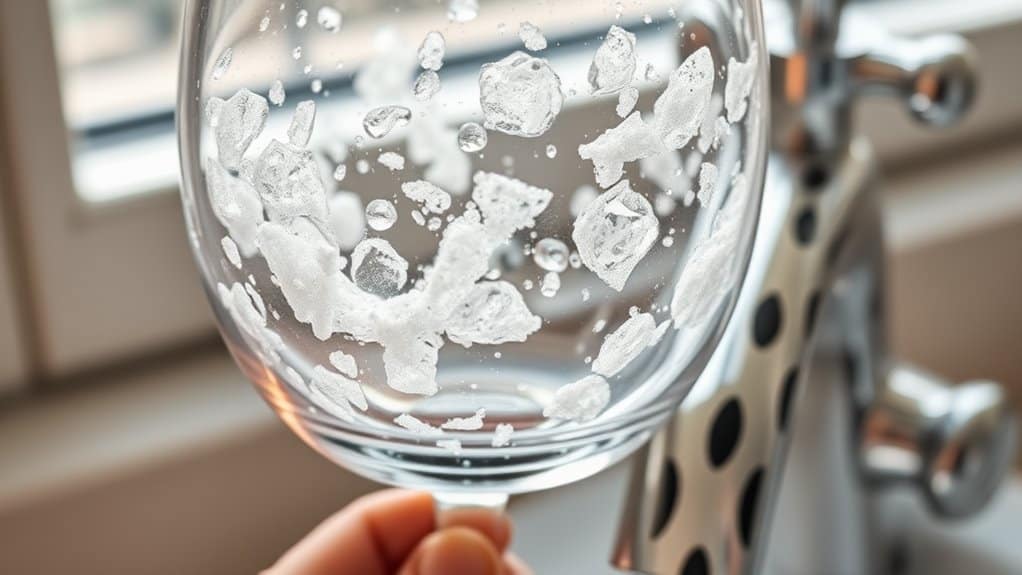
When hard water spots begin reappearing on your glassware, dishes, and bathroom fixtures despite having a water softener installed, you’re likely witnessing the first warning sign of system failure. These stubborn white spots indicate your softener isn’t effectively removing calcium and magnesium minerals from your water supply. Many homeowners resort to temporary fixes like vinegar rinses or commercial rinse aids, but these merely mask the underlying problem. Recent studies show that 85% of American homes have hard water issues that eventually overwhelm failing water softeners. Without proper mineral removal, deposits will continue to accumulate on everything that touches your water. In fact, hard water problems can lead to costly plumbing repairs if not addressed promptly. You’ll notice dishes requiring multiple washings to achieve the spotless finish your softener once provided.
Declining Water Pressure Throughout Your Home
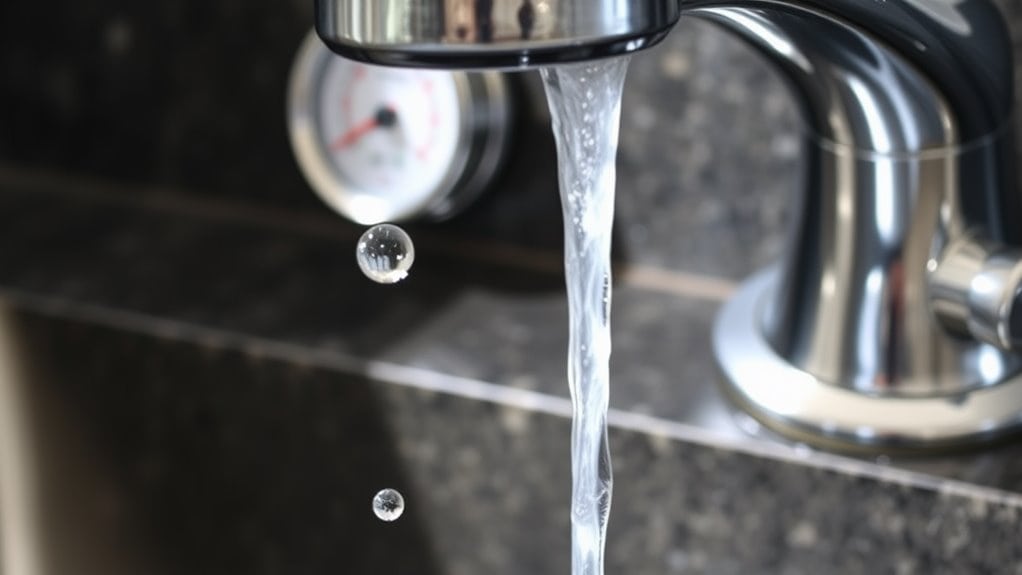
Beyond those frustrating water spots on your dishes, a more concerning sign of water softener failure manifests in declining water pressure throughout your home.
When mineral buildup accumulates in pipes due to ineffective softening, water flow becomes restricted. We often find customers overlook this connection, blaming municipal supply issues instead.
A failing system allows scale to narrow pipe diameters and clog aerators, creating cascading pressure problems. This is particularly crucial in areas prone to hard water damage, where the effects can be more pronounced.
To determine if your softener is the culprit, engage the bypass valve. If pressure improves, your system likely needs attention.
This issue compounds over time, accelerating pipe corrosion and appliance damage. Hard water areas experience significant mineral buildup more rapidly, exacerbating pressure issues in homes with failing water softeners.
Unusual Noises During Regeneration Cycles
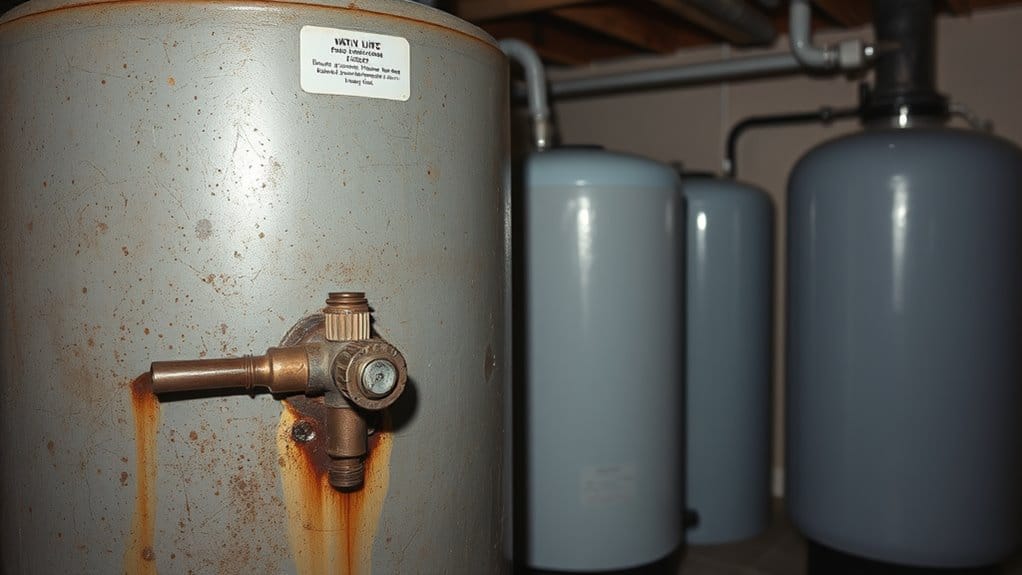
A properly functioning water softener produces consistent, predictable sounds during regeneration cycles, but unusual noises often signal impending failure.
Listen for grinding, banging, or excessive hissing—these indicate mechanical issues, loose connections, or valve malfunctions. Continuous clicking or irregular ticking suggests control valve problems or misaligned timers. Rattling often stems from trapped air or sediment buildup in the resin tank. Normal operation includes gentle humming, gurgling, or ticking sounds that should not cause concern. Additionally, many homeowners benefit from maintenance-free solutions that eliminate these issues altogether.
We’ve found that aging systems and poor maintenance significantly increase noise problems. Regular inspection of components, especially valves and motors, can prevent these issues.
If troubleshooting doesn’t resolve persistent noises, professional assessment is recommended before complete system failure occurs.
Salt Consumption Changes Dramatically

Dramatic changes in salt consumption patterns—either too much or too little—often signal underlying water softener issues that shouldn’t be ignored. We frequently observe unusual salt depletion linked directly to regeneration cycle problems, resulting from valve malfunctions, improper settings, or salt bridging in the brine tank. Additionally, an effective water softener can help mitigate these issues and improve overall performance. Monitoring your softener’s salt usage monthly can help identify these problems early, preventing system inefficiency and unnecessary operational costs. Regular inspection of the brine line and valve can prevent blockages that lead to erratic salt consumption and ineffective regeneration cycles.
Unusual Salt Levels
One of the most telling indicators of water softener malfunction is an unusual change in salt consumption patterns.
We’ve observed two common scenarios: excessive salt usage often stems from incorrect settings triggering unnecessary regeneration cycles, misaligned water hardness calculations, or brine line issues.
Conversely, insufficient salt use typically results from salt bridges, depleted brine tanks, or malfunctioning valves.
Both situations compromise efficiency and increase operational costs. Additionally, excessive salt contributes to environmental chloride pollution, impacting aquatic ecosystems.
Regular system inspections, proper maintenance of brine lines, and accurate hardness testing are essential for optimal performance.
Upgrading to demand-initiated regeneration systems significantly improves salt efficiency.
Regeneration Cycle Problems
Problematic regeneration cycles represent critical signs of water softener failure, often manifested through dramatic fluctuations in salt consumption.
We’ve identified several common culprits: faulty timers, clogged injectors, and control valve malfunctions can prevent proper regeneration, while stuck float valves affect brine tank water levels.
Watch for systems that regenerate too frequently or continuously, typically caused by incorrect timer settings or failed circuit switches.
Environmental factors like high humidity and low-quality salt contribute to salt bridging, further disrupting regeneration.
If you encounter persistent error codes or your system fails to soften water despite troubleshooting, it’s time to seek professional assistance.
Skin and Hair Feel Dry Despite Water Treatment

We often identify water softener failures when our skin and hair remain persistently dry despite ongoing water treatment.
Mineral residue from inefficiently softened water disrupts your skin’s natural moisture balance while simultaneously preventing soaps and shampoos from lathering properly.
These physical symptoms serve as reliable efficiency indicators, typically manifesting before more visible signs like scale buildup on fixtures appear. Additionally, many users have reported dramatic hair improvements after switching to a specific water softener that effectively combats these issues.
Mineral Residue Effects
Although a functioning water softener should eliminate mineral-related skin and hair issues, persistently dry skin and brittle hair could signal your system’s failure to properly remove calcium and magnesium from your water supply.
When mineral residue builds up, it strips natural oils from skin and hair, causing irritation, dullness, and increased sensitivity. These minerals form soap scum that clings to skin, exacerbating dryness.
Hair becomes difficult to style as calcium deposits cause brittleness and fading color. Each mineral presents unique problems: calcium creates dandruff, iron tints blonde hair orange, while copper can turn light hair green.
These symptoms strongly indicate your water softener needs attention.
Softener Efficiency Indicators
Even when your water softener appears to be functioning, persistent skin dryness and brittle hair serve as telltale efficiency indicators that shouldn’t be ignored.
These physical symptoms often reveal underperforming systems before other signs emerge.
We’ve found that properly softened water should leave skin feeling smooth and hair manageable.
When you’re experiencing increased itchiness, tangled hair, or discomfort while bathing, your system is likely failing to remove sufficient minerals.
Additionally, check for water pressure fluctuations, frequent or irregular regeneration cycles, and increased salt consumption.
These operational anomalies, combined with scaling on fixtures and spotty dishes, confirm declining efficiency requiring immediate attention.
Appliances Showing Premature Wear and Mineral Buildup
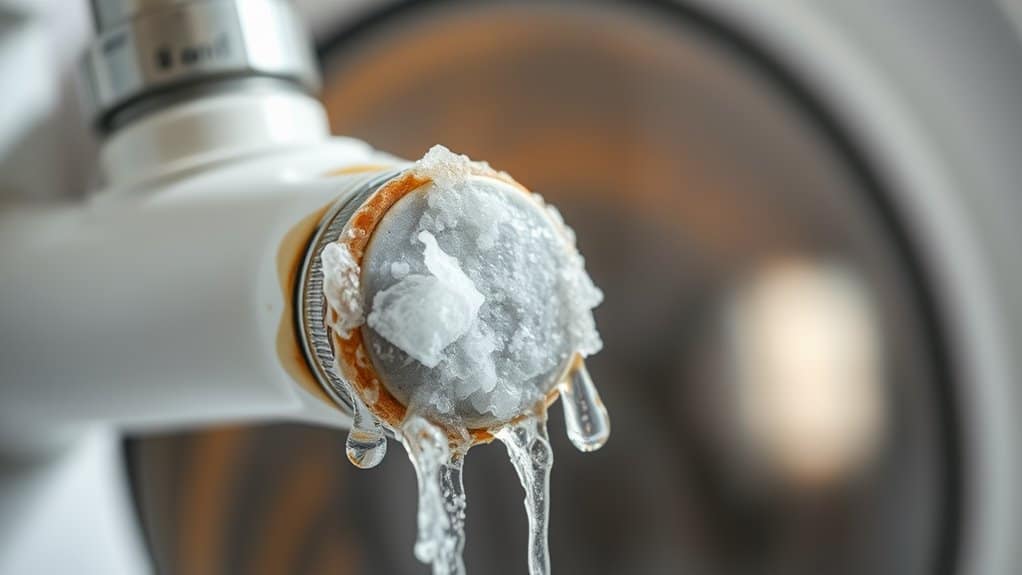
A failing water softener typically manifests first in your household appliances, as they bear the brunt of hard water’s damaging effects.
We find water heaters develop limescale insulation around heating elements, forcing them to work harder and consume more energy.
Dishwashers exhibit clogged water jets and spotty dishes, while washing machines produce stiff clothes and suffer from extended cycle times.
Even smaller appliances aren’t immune—kettles and coffee makers lose efficiency as limescale accumulates.
When you notice mineral deposits on faucets, reduced water pressure, or increasing frequency of appliance repairs, these aren’t coincidental.
They’re clear indicators your water softener is no longer performing its essential function.
The Revolutionary Salt-Free Water Conditioner That Outlasts Traditional Softeners
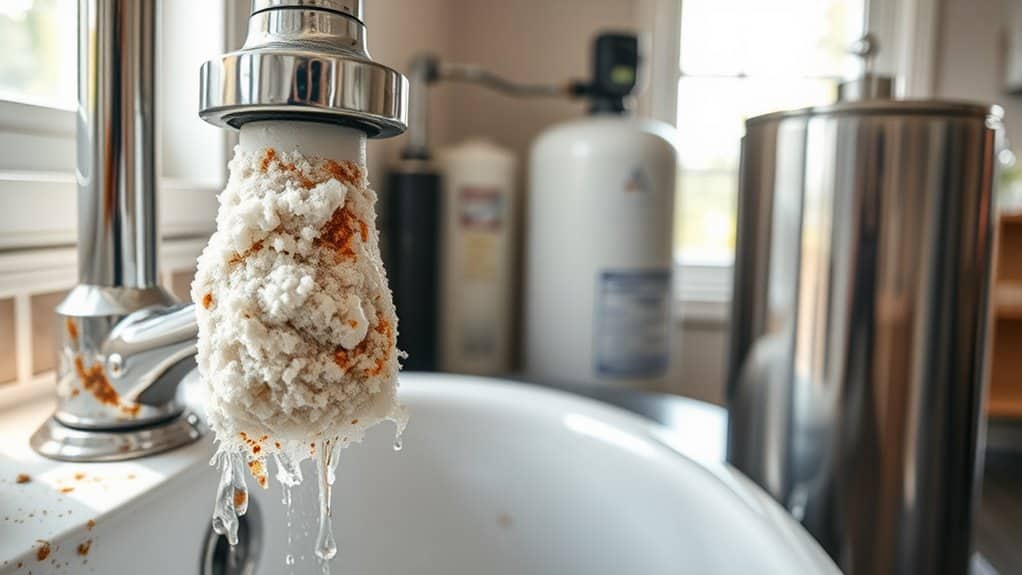
While traditional water softeners have dominated the market for decades, salt-free water conditioners represent a significant technological advancement for homeowners facing hard water issues.
These systems employ Template-Assisted Crystallization (TAC) technology to prevent scale formation without removing minerals.
Unlike conventional softeners, salt-free conditioners require no electricity, produce zero wastewater, and eliminate the need for regular salt refills.
The specialized media typically lasts 3-5 years, significantly reducing maintenance requirements and operational costs.
Though they don’t remove hardness minerals like traditional softeners do, these eco-friendly alternatives effectively prevent scale buildup while maintaining water’s natural feel—ideal for areas with moderate hardness or brine restrictions.
Frequently Asked Questions
How Do I Test Water Hardness at Home Without Special Equipment?
We recommend conducting a soapsuds test by adding liquid soap to a bottle of tap water and shaking it. Minimal suds indicate hard water, while abundant foam suggests soft water.
Can Water Softeners Cause Damage to Septic Systems?
We’ve found that inefficient water softeners can damage septic systems through excessive brine discharge, which disrupts bacterial balance and stratification. However, properly maintained, efficient units won’t compromise septic functionality when correctly installed.
Why Does My Softened Water Feel Slippery or Slimy?
We’ve found that softened water feels slippery because ion exchange replaces hard minerals with sodium ions, altering water’s texture. Additionally, soaps lather more effectively without calcium to form sticky residues on skin.
Are Salt-Free Systems Effective for Well Water With Iron?
We don’t recommend salt-free systems alone for iron-heavy well water. They prevent scale but don’t remove iron. You’ll need a dedicated iron filter system for effective treatment of ferrous contamination.
How Often Should Resin Beads Be Replaced in Traditional Softeners?
We recommend replacing resin beads every 8-10 years, though lifespan varies with water quality, usage volume, and maintenance. High iron or chlorine content will necessitate more frequent replacement.
Conclusion
We’ve identified the critical failure indicators of conventional water softening systems. When experiencing these symptoms, immediate evaluation is necessary to prevent further system degradation and household damage. Our salt-free water conditioner offers superior longevity through innovative template-assisted crystallization technology, eliminating regeneration cycles and moving parts that typically fail. It’s engineered to provide consistent performance without electricity, salt replenishment, or the maintenance requirements that plague traditional softeners. The solution isn’t repair—it’s replacement with proven technology.

Craig “The Water Guy” Phillips is the founder of Quality Water Treatment (QWT) and creator of SoftPro Water Systems.
With over 30 years of experience, Craig has transformed the water treatment industry through his commitment to honest solutions, innovative technology, and customer education.
Known for rejecting high-pressure sales tactics in favor of a consultative approach, Craig leads a family-owned business that serves thousands of households nationwide.
Craig continues to drive innovation in water treatment while maintaining his mission of “transforming water for the betterment of humanity” through transparent pricing, comprehensive customer support, and genuine expertise.
When not developing new water treatment solutions, Craig creates educational content to help homeowners make informed decisions about their water quality.


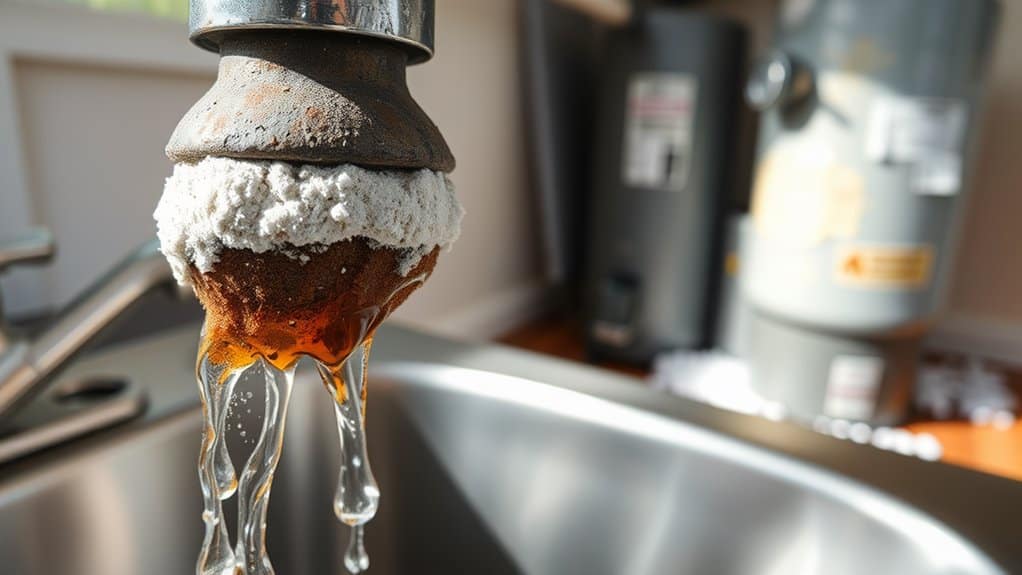
Thanks – Enjoyed this article, can you make it so I get an email when you make a new post?